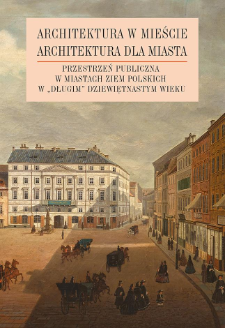- Wyszukaj w całym Repozytorium
- Piśmiennictwo i mapy
- Archeologia
- Baza Młynów
- Nauki przyrodnicze
Wyszukiwanie zaawansowane
Wyszukiwanie zaawansowane
Wyszukiwanie zaawansowane
Wyszukiwanie zaawansowane
Wyszukiwanie zaawansowane

Obiekt
Tytuł: Uniwersalne i lokalne aspekty obiektów reprezentacyjnych w przestrzeni miast habsburskich : dwa przypadki z Zagrzebia i Osijeku
Inny tytuł:
Współtwórca:
Łupienko, Aleksander (1980– ) : Redaktor ; Zabłocka-Kos, Agnieszka (1957– ) : Redaktor ; Polska Akademia Nauk. Instytut Historii im. Tadeusza Manteuffla
Wydawca:
Miejsce wydania:
Opis:
s. 69-87 : il. (w tym kolorowe) ; 24 cm ; Abstrakt w języku angielskim.
Typ obiektu:
Abstrakt:
This text indicates, on the one hand, the sense-making potential of architecture, and on the other hand, the necessity to be familiar with the social and political context when interpreting urban planning decisions. The subject of research is two representative yet sacred buildings constructed at the same time in the two most important cities of the Kingdom of Croatia-Slavonia: in Zagreb and Osijek. In the first case, the inside story of the cathedral’s reconstruction after the 1880 earthquake is examined, while in the latter, the background of architectural competition is described, together with the construction of a new parish church in the central district, consecrated in 1900. Both structures were constructed in the neo-Gothic style, and both were to play an important role in each city’s growth, forming a distinct dominant marker in the city with the potential of centrality. The purpose of the reconstruction of the cathedral and of the creation of a new city centre at the same time was to construct a representative national space which would make it possible to express the idea of Croatian sovereignty. A new cathedral building was better suited to the opinions of the prototypical image of the central part of a European capital city. In the case of Osijek, however, the new representative buildings did not inscribe in any of national ideologies. In the light of documents and the socio-political situation at that time, we are justified in interpreting the reconstruction of the city as a programme of the central district of the new middle class aspiring to play a dominant role. Thus,these two sacred buildings, although they both sprang from similar assumptions and architectural fashion, inscribe to different contexts, testifying to the interesting dialectic of universality and particularity.
Strona pocz.:
Strona końc.:
Szczegółowy typ zasobu:
Identyfikator zasobu:
oai:rcin.org.pl:140636 ; 978-83-65880-53-6
Źródło:
IH PAN, sygn. II.14682 ; IH PAN, sygn. II.14681 Podr. ; kliknij tutaj, żeby przejść
Język:
Język streszczenia:
Prawa:
Licencja Creative Commons Uznanie autorstwa-Bez utworów zależnych 4.0
Zasady wykorzystania:
Zasób chroniony prawem autorskim. [CC BY-ND 4.0 Międzynarodowe] Korzystanie dozwolone zgodnie z licencją Creative Commons Uznanie autorstwa-Bez utworów zależnych 4.0, której pełne postanowienia dostępne są pod adresem: ; -
Digitalizacja:
Instytut Historii Polskiej Akademii Nauk
Lokalizacja oryginału:
Biblioteka Instytutu Historii PAN
Dostęp:
Kolekcje, do których przypisany jest obiekt:
- Repozytorium Cyfrowe Instytutów Naukowych > Kolekcje Partnerów > Instytut Historii PAN > Książki
- Repozytorium Cyfrowe Instytutów Naukowych > Kolekcje Partnerów > Instytut Historii PAN > Wydawnictwa Instytutu
- Repozytorium Cyfrowe Instytutów Naukowych > Kolekcje Partnerów > Instytut Historii PAN > Wydawnictwa Instytutu > Książki
- Repozytorium Cyfrowe Instytutów Naukowych > Piśmiennictwo > Książki/Rozdziały
Data ostatniej modyfikacji:
2 paź 2020
Data dodania obiektu:
23 wrz 2020
Liczba pobrań / odtworzeń:
56
Wszystkie dostępne wersje tego obiektu:
https://rcin.org.pl./publication/174786
Wyświetl opis w formacie RDF:
Wyświetl opis w formacie RDFa:
Wyświetl opis w formacie OAI-PMH:
Obiekty Podobne
Łupienko, Aleksander (1980– )
Łupienko, Aleksander (1980– ) Zabłocka-Kos, Agnieszka (1957– )
Makała, Rafał (1967– )
Hanzl, Małgorzata
Getka-Kenig, Mikołaj (1987– ) Łupienko, Aleksander (1980– )

 INSTYTUT ARCHEOLOGII I ETNOLOGII POLSKIEJ AKADEMII NAUK
INSTYTUT ARCHEOLOGII I ETNOLOGII POLSKIEJ AKADEMII NAUK
 INSTYTUT BADAŃ LITERACKICH POLSKIEJ AKADEMII NAUK
INSTYTUT BADAŃ LITERACKICH POLSKIEJ AKADEMII NAUK
 INSTYTUT BADAWCZY LEŚNICTWA
INSTYTUT BADAWCZY LEŚNICTWA
 INSTYTUT BIOLOGII DOŚWIADCZALNEJ IM. MARCELEGO NENCKIEGO POLSKIEJ AKADEMII NAUK
INSTYTUT BIOLOGII DOŚWIADCZALNEJ IM. MARCELEGO NENCKIEGO POLSKIEJ AKADEMII NAUK
 INSTYTUT BIOLOGII SSAKÓW POLSKIEJ AKADEMII NAUK
INSTYTUT BIOLOGII SSAKÓW POLSKIEJ AKADEMII NAUK
 INSTYTUT CHEMII FIZYCZNEJ PAN
INSTYTUT CHEMII FIZYCZNEJ PAN
 INSTYTUT CHEMII ORGANICZNEJ PAN
INSTYTUT CHEMII ORGANICZNEJ PAN
 INSTYTUT FILOZOFII I SOCJOLOGII PAN
INSTYTUT FILOZOFII I SOCJOLOGII PAN
 INSTYTUT GEOGRAFII I PRZESTRZENNEGO ZAGOSPODAROWANIA PAN
INSTYTUT GEOGRAFII I PRZESTRZENNEGO ZAGOSPODAROWANIA PAN
 INSTYTUT HISTORII im. TADEUSZA MANTEUFFLA POLSKIEJ AKADEMII NAUK
INSTYTUT HISTORII im. TADEUSZA MANTEUFFLA POLSKIEJ AKADEMII NAUK
 INSTYTUT JĘZYKA POLSKIEGO POLSKIEJ AKADEMII NAUK
INSTYTUT JĘZYKA POLSKIEGO POLSKIEJ AKADEMII NAUK
 INSTYTUT MATEMATYCZNY PAN
INSTYTUT MATEMATYCZNY PAN
 INSTYTUT MEDYCYNY DOŚWIADCZALNEJ I KLINICZNEJ IM.MIROSŁAWA MOSSAKOWSKIEGO POLSKIEJ AKADEMII NAUK
INSTYTUT MEDYCYNY DOŚWIADCZALNEJ I KLINICZNEJ IM.MIROSŁAWA MOSSAKOWSKIEGO POLSKIEJ AKADEMII NAUK
 INSTYTUT PODSTAWOWYCH PROBLEMÓW TECHNIKI PAN
INSTYTUT PODSTAWOWYCH PROBLEMÓW TECHNIKI PAN
 INSTYTUT SLAWISTYKI PAN
INSTYTUT SLAWISTYKI PAN
 SIEĆ BADAWCZA ŁUKASIEWICZ - INSTYTUT TECHNOLOGII MATERIAŁÓW ELEKTRONICZNYCH
SIEĆ BADAWCZA ŁUKASIEWICZ - INSTYTUT TECHNOLOGII MATERIAŁÓW ELEKTRONICZNYCH
 MUZEUM I INSTYTUT ZOOLOGII POLSKIEJ AKADEMII NAUK
MUZEUM I INSTYTUT ZOOLOGII POLSKIEJ AKADEMII NAUK
 INSTYTUT BADAŃ SYSTEMOWYCH PAN
INSTYTUT BADAŃ SYSTEMOWYCH PAN
 INSTYTUT BOTANIKI IM. WŁADYSŁAWA SZAFERA POLSKIEJ AKADEMII NAUK
INSTYTUT BOTANIKI IM. WŁADYSŁAWA SZAFERA POLSKIEJ AKADEMII NAUK


































